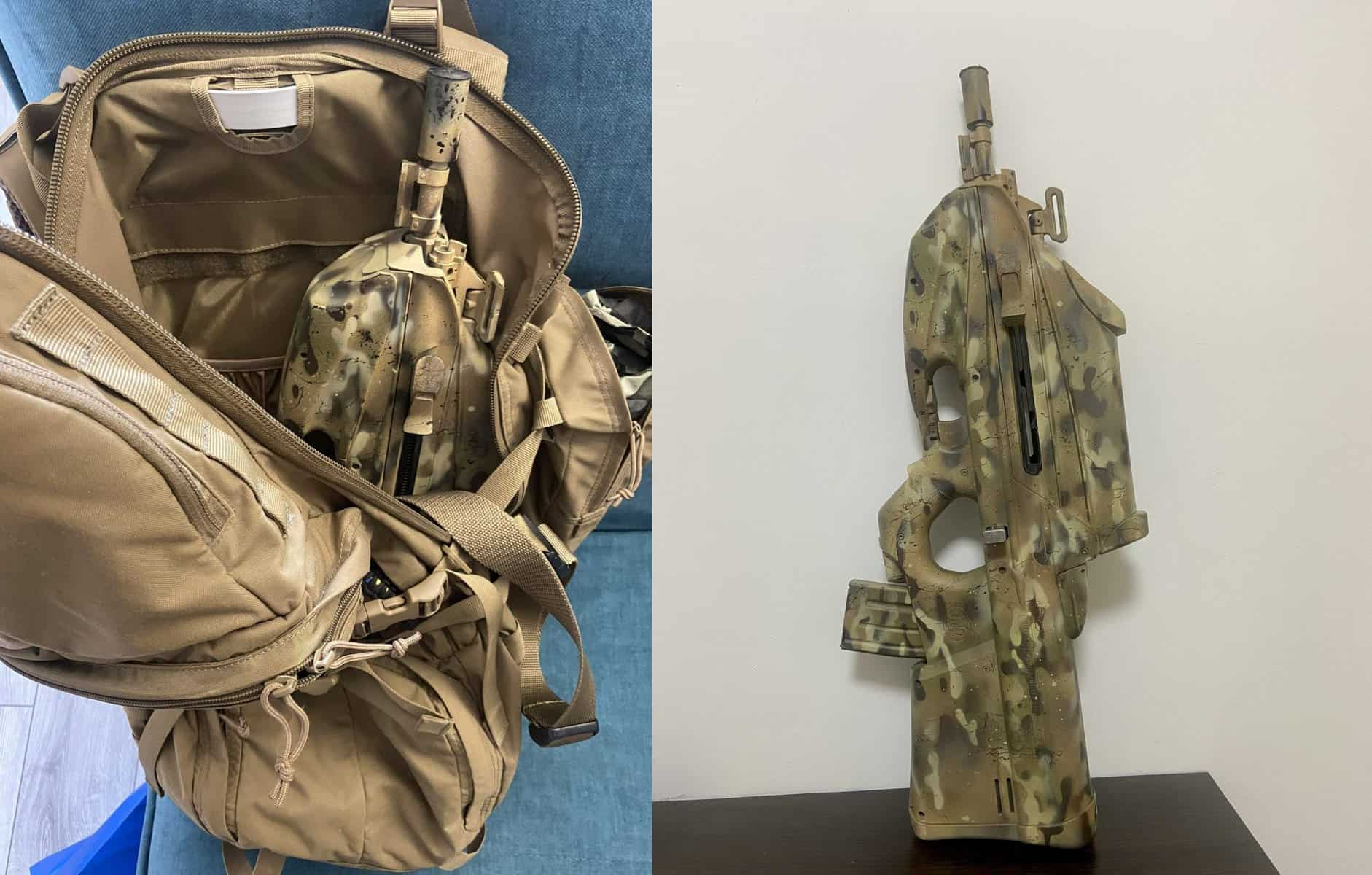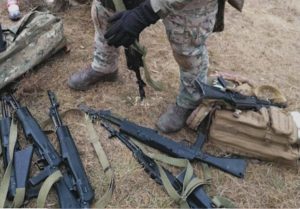FN F2000 Operating Experience by Ukrainian Soldier
Disclaimer: I am not a weapons expert and am describing only my own subjective experience. You can take this as a “foxhole rumor” from a fellow soldier in the neighboring dugout. The enemy already had captured such a weapon, so nothing I mention here is classified. However, I hope this information proves helpful to my fellas and colleagues who may get this weapon in their hands.
Reliability
Over the past two years and approximately 2,500 rounds fired, this weapon has let me down only rarely. Any issues I encountered were either due to my cack-handedness (at the beginning) or rounds catching on the edge of the magazine, causing feeding failures.
The cack-handedness was (almost) eliminated with dry fire training. Jamming was fixed by inspecting the magazines for deformation and filing or bending the deformed elements. I’ve had no issues with new, high-quality metal magazines.
The FN operates with standard NATO metal magazines. Of course, my first thought was to replace them with plastic ones, which, based on my experience, are more reliable. However, all the plastic magazines I could find didn’t fit—they got stuck at the front of the magazine well.
You can either put up with it or grab some fine sandpaper and file down the plastic magazines until they fit (it’s doable, I’ve done it).
One other thing to note: even with a single caliber (5.56mm), swapping magazines isn’t as easy as it might seem. Your magazines will fit everyone else’s, but only metal ones will fit yours. And that was the biggest problem I encountered with this rifle.
(I assume a suitable plastic magazine exists, but I couldn’t find one.)
Changing the magazine
Changing the magazine in the FN is a bit unusual and is done like this:
You hold down the large button next to the magazine well, then pull the magazine out (no, it won’t just fall out on its own!). After that, you insert the new magazine and press it in until you hear the typical click.
Compared to AKs or ARs, this is a bit unconventional and takes some practice. However, I’m now pretty comfortable doing it (almost) in any position.
As for why the magazine doesn’t just fall out when you press the button, like in ARs, it’s held inside by two rubber gaskets. These help protect the rifle from dirt and dust. In theory, they could tear off, and then the magazine would fall out. I haven’t done this and wouldn’t recommend it.

Safety and firing mode selector
This mechanism is designed as a simple wheel that switches between safe, single, and automatic fire positions. It’s naturally placed under the index finger and is comfortable to use whether you’re left or right-handed. I got used to it instantly.
And it clicks very nicely and quietly 😍.
I’ve had no issues with accidental switching. It can happen on rifles that aren’t put together right, but it’s easily fixed by tightening a screw near the wheel.
Dimensions and design
Thanks to its layout, the FN is super compact with a normal barrel size: 68 cm overall length and a 40 cm barrel. This makes it easy to transport, even folded, in a 60-liter backpack. Even less when disassembled!
The “sleek” design is very practical and doesn’t snag on anything. The plastic case is also more comfortable in hot or cold weather since it won’t burn your hands. The only downside to this design is that the “space blaster” tends to draw attention from locals, which, as we all know, is something we don’t want.
At 187 cm tall with the length of my arms, I feel super comfortable wearing the FN. The wide back of the stock makes it comfortable even when wearing armor and a backpack.
I’ve heard less favorable reviews from shorter guys and girls. The reason: the forend essentially has one position, and it’s unrealistic to adjust it. Theoretically, you could remove the barrel cover and install an additional handle, but I’ve never seen anyone do that, nor did I feel the need to.
Compared to the AK/AR stock, the bullpup design puts (subjectively) more strain on the right hand when shooting from the right shoulder. But, honestly, I don’t see this as an issue. It might even be the opposite.

The trigger
First of all, it’s hard to call this thing a “trigger.” To me, it looks more like a button. Compared to the AK/AR, it’s wider. It has a very clear and controlled stroke, which makes it possible to “cut off” single or split rounds in automatic mode.
I don’t rule out that this might be possible on other platforms, but I wasn’t able to master this skill on the AK/AR. If you’re sure it’s doable, then I’ll take the blame. Let’s move on.
Sighting devices
The standard equipment (which I received) included a standard optical sight with a magnification of x1.6 (or x1.7). The reticle and front sight are located on the top protective cover.
The optical sight is mounted on a standard Picatinny rail, so it can be swapped out for something else if needed. However, you’ll have to remove the protective cover and attach backup sights. I’ve seen collimators, red dot sights, and thermal sights mounted on the FN.
Ejection of spent cartridges
Casings don’t fly out of the FN 🥰, and that’s some kind of “magic.” They’re directed into a special channel. The first six are quietly stored inside, and after the 7th shot, the window opens, and the casings fall out. This is the first weapon I’ve seen that doesn’t rain shell casings down on your fellow soldiers.
This also gives a huge advantage when unloading, as the casing rolls quietly inside the channel, making it easy to retrieve, instead of flying off wherever it pleases (yes, you can try to catch the flying casing with your palm, but… this way is definitely more convenient).
The gas block is adjustable. In case of severe contamination, you can switch to “full throttle” mode. I tried it—works great 👌
Camouflage
The profile of the FN is very wide. In its unpainted (black) form, it’s extremely noticeable! If there are no restrictions on painting, it’s a must (actually, it’s a must for all weapons).
If the unit doesn’t allow painting the barrels (which, in my opinion, should be reprimanded!), the only option is camouflage tapes. That’s how I managed for the first 9 months, but it only helped partially.

Belt
This is the second biggest problem (in my subjective rating). The standard belt is as uncomfortable as it gets. There’s no one-point sling, and none of the ones on the market fit it.
The only solution I could come up with was to improvise by throwing it over the thumbhole and hanging it on a regular belt.
Theoretically, you could remove the casing and install an adapter for the belt, but I’m not ready to give up the benefits of the case.
Cleaning
Some parts are difficult to clean, but in general, it’s no harder than the AR. You can see the full assembly/disassembly here 👇
The rifle comes with a protective cap against dirt. It might seem like a small thing, but in practice, it’s pure bliss!!!
It’s also worth mentioning that the FN is very sealed, so even when swimming in mud, with the protective cap on and the magazine inserted, it will stay clean and ready for action.
What happens if you forget to remove the protective cap? It’ll get torn or just fall off. The cap will get pierced, but it won’t affect the operation. I’ve tested it myself! To replenish the stock of caps, we print them on a 3D printer.
As for the trigger mechanism, all I can say is that it’s plastic and doesn’t corrode, even in very humid conditions (because, well, it’s plastic).
Instead of a conclusion
This is definitely a very interesting, reliable, and quite handy weapon. Despite the issues with the magazines, I’m pretty satisfied with it, and it’s perfect for my needs. Although, I did end up buying a semi-automatic shotgun 😂.
SUPPORT MILITARNYI
Even a single donation or a $1 subscription will help us contnue working and developing. Fund independent military media and have access to credible information.


 Urich
Urich 
 Андрій Харук
Андрій Харук 
 Контужений Безпілотник
Контужений Безпілотник 

 Центр ініціатив ПЖ
Центр ініціатив ПЖ 



 Vadim Kushnikov
Vadim Kushnikov 
 Андрій Тарасенко
Андрій Тарасенко 
 Юрій Юзич
Юрій Юзич 
 Віктор Шолудько
Віктор Шолудько 
 Роман Приходько
Роман Приходько 


